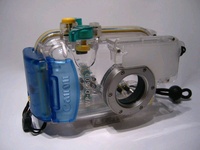
Underwater imaging is considered an especially challenging area of photography, since it requires very specialized equipment and techniques to be successful. Despite these challenges, it offers the possibility of many exciting and rare photographic opportunities. Animals such as fish and marine mammals are the most common subjects, but photographers also pursue shipwrecks, submerged cave systems, underwater "landscapes", and portraits of fellow divers. The primary obstacle faced by underwater photographers is the extreme loss of color and contrast when submerged to any significant depth. The longer wavelengths of sunlight (such as red or orange) are absorbed quickly by the surrounding water, so even to the naked eye everything appears blue-green in color. The loss of color not only increases vertically through the water column, but also horizontally, so subjects further away from the camera will also appear colorless and indistinct. This effect is true even in apparently clear water, such as that found around tropical coral reefs. Underwater photographers solve this problem by combining two techniques. The first is to get the camera as close to the photographic subject as possible, minimizing the horizontal loss of color. This is best achieved by using wide-angle lenses, which allow very close focus, or macro lenses, where the subject is often only inches away from the camera. In practical terms, serious underwater photographers consider any more than about 3 ft/1 m of water between camera and subject to be unacceptable. The second technique is the use of flash to restore any color lost vertically through the water column. Fill-flash, used effectively, will "paint" in any missing colors by providing full-spectrum visible light to the overall exposure. Since underwater photography is often performed while scuba diving, it is important that the diver-photographer be sufficiently skilled so that it remains a reasonably safe activity. Good scuba technique also has an impact on the quality of images, since marine life is less likely to be scared away by a calm diver, and the environment is less likely to be damaged or disturbed. There is the possibility of encountering poor conditions, such as heavy currents, tidal flow, or poor visibility. Generally, underwater photographers try to avoid these situations whenever possible.